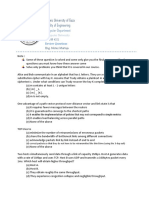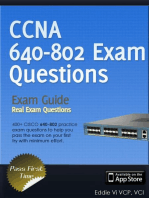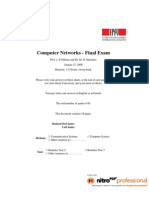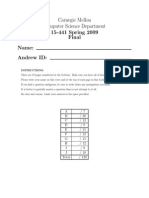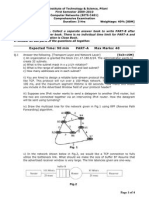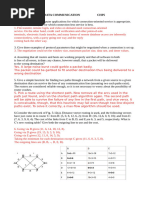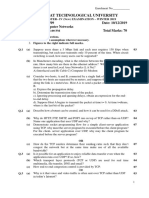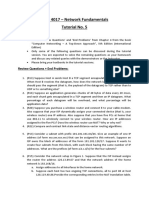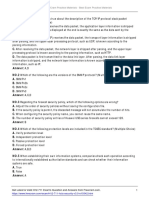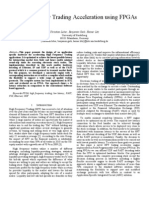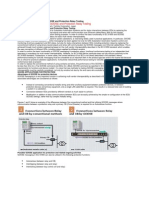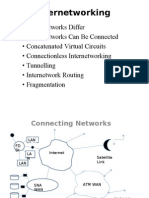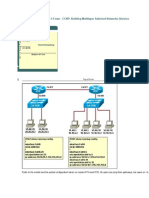HW 6
HW 6
Uploaded by
Anthony Yueh Grsy CaCopyright:
Available Formats
HW 6
HW 6
Uploaded by
Anthony Yueh Grsy CaOriginal Description:
Original Title
Copyright
Available Formats
Share this document
Did you find this document useful?
Is this content inappropriate?
Copyright:
Available Formats
HW 6
HW 6
Uploaded by
Anthony Yueh Grsy CaCopyright:
Available Formats
Written Homework (mini-homework)
Please submit this homework by email to
jsantisteban@ucsp.edu.pe
Note: In all written assignments, please show as much of your work as you can. Even if you
get a wrong answer, you can get partial credit if you show your work. If you make a mistake,
it will also help the grader show you where you made a mistake. Your submitted homework
should be printed out (i.e., please dont hand in hand-written answers, unless you need to
hand-annotate the printed text, or draw a figure). See the class web-page for more
information about handing in homework assignments.
Problem 1. IP and MAC addresses.
a) Suppose you (a sender connected to a LAN on the UMass campus) want to send an IP
datagram to a friend whose laptop is connected to a LAN, at Boston University in
Boston. Does your laptop know the 48-bit MAC address of your friends laptop at BU?
If so, how does it get the MAC address, if not, then explain why it does not need to
know the MAC address.
b) Consider the link-layer frame that arriving at your friends computer that contains the
IP datagram that you sent from your UMass-connected computer. Consider the source
MAC address in that frame - what is the network device (host, router) whose MAC
address is the source MAC address in that frame?
c) Now consider the IP datagram inside the frame arriving at your friends computer.
What is the network device (host router) whose IP address is the source IP address in
the IP datagram contained in that frame?
Problem 2. ARP and Learning Switches. Consider the network shown below.
Suppose that source node A wants to send an IP datagram, encapsulated in an Ethernet frame
to node H. Before doing so, A uses ARP to find Hs MAC address. A then sends an Ethernet
frame to H and H then sends a reply back to A. Suppose that initially the switch tables are
empty at all switches, and that all ARP tables are empty.
a) Give the switch tables for S1, S2, S3 and S4 after the ARP request packet is received at
H.
b) How many of hosts A through I receive the ARP request?
c) Give the switch tables for S1, S2, S3 and S4 after the ARP reply packet has been sent by
H and has been received at A.
d) Give the switch tables for S1, S2, S3 and S4 after the IP datagram has been sent by A
and has been received at H.
e) How many of hosts A through I receive the frame containing the A-to-H datagram?
Problem 3: In this problem well consider three multiple access LAN protocols TDMA,
polling, and CSMA/CD. Suppose there are 100 nodes on the LAN. In TDMA, assume that
each slot is 10 milliseconds long, that each node is assigned one frame per second, and that a
frame takes 10 milliseconds to send. In the case of polling, assume that a polling request
takes 1 milliseconds to get from the central polling node to any node in the network.
a) Suppose that nodes on the LAN want to send a lot of network traffic and so any given
node almost always has a frame that it wants to send. For each of the three multiple
access LAN protocols, what is longest possible time that a node can wait before
successfully (i.e., collision free) send its frame into the LAN.
b) Now suppose that there is almost no traffic in the LAN, so that whenever a node has a
frame to send, there are no other nodes that also have a frame to send. In this case, for
each of the three multiple access LAN protocols, what is the average amount of time
until a node is able to successfully send its frame?
You might also like
- Communication+Protocol+Manual CMDDocument21 pagesCommunication+Protocol+Manual CMDEnrique CrespoNo ratings yet
- Final Exam 2002 Umass SolutionsDocument6 pagesFinal Exam 2002 Umass SolutionsFeyisa AyaleNo ratings yet
- Answer SheetDocument8 pagesAnswer SheetChris McoolNo ratings yet
- DVM BT p2pDocument4 pagesDVM BT p2panuashkNo ratings yet
- Lesson 2 Assignment Networking FundamentalsDocument2 pagesLesson 2 Assignment Networking FundamentalsTyler Kristian CourtneyNo ratings yet
- QADocument9 pagesQAkiet eduNo ratings yet
- Blanc Comp Net Exam Fall 09Document20 pagesBlanc Comp Net Exam Fall 09jerome_bovay5831No ratings yet
- COSC 328 Lab 8-Link-LayerDocument4 pagesCOSC 328 Lab 8-Link-LayerAbhishek DashNo ratings yet
- Exam #1 For Computer Networks (CIS 6930) SOLUTIONS : Problem #1Document5 pagesExam #1 For Computer Networks (CIS 6930) SOLUTIONS : Problem #187bbNo ratings yet
- Datalink AnswersDocument3 pagesDatalink AnswersNguyễn Văn HiếnNo ratings yet
- Final Fall2005Document4 pagesFinal Fall2005edeNo ratings yet
- CNBTECHENDSEMit2014Document2 pagesCNBTECHENDSEMit2014yesfirst000No ratings yet
- Midterm Exam With SOLUTIONS PDFDocument6 pagesMidterm Exam With SOLUTIONS PDFKiruba KaranNo ratings yet
- EC 504 End Semester QPDocument3 pagesEC 504 End Semester QPVinod PrakashNo ratings yet
- CN Assignment 3 2022-23Document4 pagesCN Assignment 3 2022-23SANDEEP KUMARNo ratings yet
- On Tap NWC203c Sum23 - 2Document10 pagesOn Tap NWC203c Sum23 - 2Tran Quoc Viet (K17 HL)No ratings yet
- Cmu 15 441 Final Spring2008Document16 pagesCmu 15 441 Final Spring2008NickHenryNo ratings yet
- Blanc Comp Net Exam Fall 08Document18 pagesBlanc Comp Net Exam Fall 08jerome_bovay5831No ratings yet
- CNBTECHENDSEMIT2015Document2 pagesCNBTECHENDSEMIT2015yesfirst000No ratings yet
- NWC203c Summer 2022 Sample PEDocument9 pagesNWC203c Summer 2022 Sample PE09.Nguyễn Anh Tuấn K17No ratings yet
- IP Addresses ProblemsDocument18 pagesIP Addresses ProblemsPhysics squadNo ratings yet
- Computer Network Previous YearDocument4 pagesComputer Network Previous Yearvickyinnocent122No ratings yet
- Cau Hoi On Tap NWC203c Spring 2022Document7 pagesCau Hoi On Tap NWC203c Spring 2022Lê Nghìn tỉNo ratings yet
- Exercises NetworkingDocument5 pagesExercises NetworkingDo ReNo ratings yet
- On Tap NWC203c Fall2022Document9 pagesOn Tap NWC203c Fall2022PjRNo ratings yet
- New Kill4exam 100-105 PDF - Cisco Interconnecting Cisco Networking Devices Part 1 (ICND1 v3.0)Document11 pagesNew Kill4exam 100-105 PDF - Cisco Interconnecting Cisco Networking Devices Part 1 (ICND1 v3.0)Isaac M. JamesNo ratings yet
- Practice Questions For MCADocument4 pagesPractice Questions For MCAmanisha bhandariNo ratings yet
- CNEP3Document3 pagesCNEP3Nauman MasoodNo ratings yet
- Comnets Review Questions Spring 2015Document5 pagesComnets Review Questions Spring 2015Nithin ChandyNo ratings yet
- Practice Problems For Chapter 5-SolDocument5 pagesPractice Problems For Chapter 5-SolAckeema JohnsonNo ratings yet
- Blanc Comp Net Exam Fall 10Document18 pagesBlanc Comp Net Exam Fall 10jerome_bovay5831No ratings yet
- A-IDocument6 pagesA-I2021ucp1377No ratings yet
- 21fa MidtermDocument15 pages21fa MidtermmisschuachinNo ratings yet
- CN Wk5 Assignment#2Document3 pagesCN Wk5 Assignment#2Malik AwanNo ratings yet
- CST 311introduction To Computer Networks Final: in Your Answer Sheet Please Remember To Write Your NameDocument6 pagesCST 311introduction To Computer Networks Final: in Your Answer Sheet Please Remember To Write Your Nameapi-360110588No ratings yet
- Computer NetworkDocument7 pagesComputer NetworkMohit UppalNo ratings yet
- Cmu 15 441 Final Spring2009Document19 pagesCmu 15 441 Final Spring2009NickHenryNo ratings yet
- Tutorial 8 QnsDocument3 pagesTutorial 8 Qnszhangyiheng0810No ratings yet
- Midterm SolutionDocument5 pagesMidterm SolutionsyhonaaNo ratings yet
- Homework Assignment #3: EE122: Introduction To Communication Networks (Fall 2007)Document4 pagesHomework Assignment #3: EE122: Introduction To Communication Networks (Fall 2007)Jack Chen Su-LeeNo ratings yet
- Expected Time: 90 Min Part-A Max Marks: 40Document4 pagesExpected Time: 90 Min Part-A Max Marks: 40ChaitanyaLukkaNo ratings yet
- Assignemnt (1)Document2 pagesAssignemnt (1)2021ucp1377No ratings yet
- Vendor: Cisco Exam Code: 200-125: CCNA (v3.0)Document14 pagesVendor: Cisco Exam Code: 200-125: CCNA (v3.0)daraNo ratings yet
- Assignment 01 Computer NetworkDocument11 pagesAssignment 01 Computer NetworkAamish AliNo ratings yet
- DCN Fall2015 MidtermExam V1.1 SolutionDocument21 pagesDCN Fall2015 MidtermExam V1.1 SolutionHUMPHREY SAKALANo ratings yet
- Question 1: Chose The Correct AnswerDocument4 pagesQuestion 1: Chose The Correct AnswerMony JosephNo ratings yet
- Assignment 1.DocxDocument3 pagesAssignment 1.Docx2021ucp1377No ratings yet
- Data NetworkDocument5 pagesData Networkabdulhameednasir131100% (1)
- W2019-2140709-APY MAterialDocument2 pagesW2019-2140709-APY MAterialMeet PatelNo ratings yet
- Rules:: Final Exam / Network Fundamentals 30 Sept-2013Document6 pagesRules:: Final Exam / Network Fundamentals 30 Sept-2013Lâm QuỳnhNo ratings yet
- Computer Science 461 Final Exam May 22, 2012 1:30-3:30pm: NameDocument8 pagesComputer Science 461 Final Exam May 22, 2012 1:30-3:30pm: NameReza ShakeriNo ratings yet
- Rules:: Final Exam / Network Fundamentals 30 Sept-2013Document6 pagesRules:: Final Exam / Network Fundamentals 30 Sept-2013Lâm QuỳnhNo ratings yet
- Computer Networks - Chapter 5 - Data Link LayerDocument9 pagesComputer Networks - Chapter 5 - Data Link LayerNirzor LiveNo ratings yet
- AssignmentDocument6 pagesAssignmentMohammad AliNo ratings yet
- ELEN 4017 - Network Fundamentals Tutorial No. 5: InstructionsDocument3 pagesELEN 4017 - Network Fundamentals Tutorial No. 5: Instructionsasadmehmud5934100% (1)
- NR-320502 Computer NetworksDocument6 pagesNR-320502 Computer NetworksSrinivasa Rao G100% (2)
- Assignm End Sem NetworkingDocument3 pagesAssignm End Sem NetworkinganukalpkumarthakurNo ratings yet
- Ccna 1 Practice QuestionsDocument12 pagesCcna 1 Practice QuestionsDua Arsalan100% (1)
- Chapter 1 Device Configuration PDFDocument24 pagesChapter 1 Device Configuration PDFShambel WorkuNo ratings yet
- PDN 078927Document164 pagesPDN 078927Cesarsanfelice100% (1)
- Lab 4: Network Packet Capture and Analysis Using Wireshark: 4.1 DetailsDocument10 pagesLab 4: Network Packet Capture and Analysis Using Wireshark: 4.1 Detailscharles81No ratings yet
- CN PracticalDocument37 pagesCN Practicaldiyen85656No ratings yet
- Java TCP Programming: Transmission Control ProtocolDocument17 pagesJava TCP Programming: Transmission Control ProtocolAnik100% (1)
- h12-711 HCIA-SECURITY QN12 20QNDocument4 pagesh12-711 HCIA-SECURITY QN12 20QNEDWARD KIWALABYENo ratings yet
- SDN Van NotesDocument26 pagesSDN Van Notesmjsmith11No ratings yet
- High Frequency Trading A Cceleration Using FPGAsDocument6 pagesHigh Frequency Trading A Cceleration Using FPGAsIgorNo ratings yet
- High Performance IEC 61850 GOOSE and Protection Relay TestingDocument5 pagesHigh Performance IEC 61850 GOOSE and Protection Relay TestingfaizansnNo ratings yet
- Tugas Pra UTS ENG VersionDocument6 pagesTugas Pra UTS ENG VersionveronikaNo ratings yet
- Writing and Adapting Device Drivers For FreeBSDDocument93 pagesWriting and Adapting Device Drivers For FreeBSDfermarioNo ratings yet
- RISC-V QingKeV2 Microprocessor Debug ManualDocument22 pagesRISC-V QingKeV2 Microprocessor Debug Manualjhvjhv202No ratings yet
- PacketSwitching CaseStudy v1 CDocument6 pagesPacketSwitching CaseStudy v1 Cphong0399266923No ratings yet
- An Introduction To Resilient Packet Ring TechnologyDocument16 pagesAn Introduction To Resilient Packet Ring TechnologyÖzzesh KaspalNo ratings yet
- Internetworking, Fragmentation, IPv4Document43 pagesInternetworking, Fragmentation, IPv4ashishpareek17105560100% (4)
- CompTIA Network+ NotesDocument30 pagesCompTIA Network+ NotesKeshav Ujoodha100% (1)
- CountersDocument56 pagesCountersyuvarajan DuraiNo ratings yet
- SYNESIS IntroductionDocument11 pagesSYNESIS Introductiona_istudorNo ratings yet
- Tutor Netw Sec Attacks.6017Document21 pagesTutor Netw Sec Attacks.6017ahmedNo ratings yet
- Career Power: 3. Which of The Following Protocol Is Not Used in The Internet?Document7 pagesCareer Power: 3. Which of The Following Protocol Is Not Used in The Internet?Akshay singhNo ratings yet
- Ewsd v16Document89 pagesEwsd v16Eugen BleulerNo ratings yet
- Networking QuestionsDocument18 pagesNetworking QuestionsNani ChowdaryNo ratings yet
- Security Issues in Wireless SystemsDocument60 pagesSecurity Issues in Wireless SystemsMadhur AgrawalNo ratings yet
- 2 MarksDocument38 pages2 Marksrajesh053007No ratings yet
- PTCL Internship Report-2015Document26 pagesPTCL Internship Report-2015Hamza Shahid100% (1)
- CCNP Module 4 Test-Building Multilayer Switched NetworksDocument9 pagesCCNP Module 4 Test-Building Multilayer Switched NetworksFidel RockwellNo ratings yet
- Net WorkDocument751 pagesNet WorkSwapnil MehtaNo ratings yet
- A1 10805443Document8 pagesA1 10805443Archana SinhaNo ratings yet
- SP1900 ManualDocument129 pagesSP1900 ManualCheme UtmNo ratings yet





